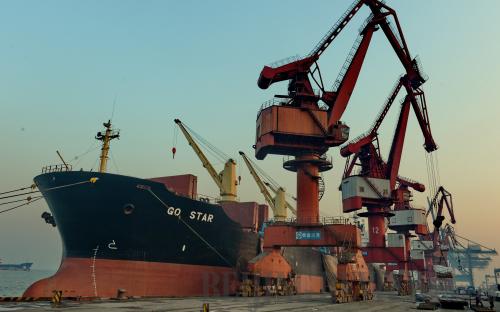|
 |
|
SHIPPING BOOM: A cargo ship is loaded up with containers at a port belonging to the Qinhuangdao Port Co. Ltd. The throughput of the company reached a record high of 364.98 million tons in 2013, up 4.4 percent from 2012 (YANG SHIYAO) |
Downgrading Ratings
On January 23, Dagong, China's domestic ratings agency, downgraded the rating outlook for New Zealand from stable to negative partly due to downward pressures on its economic growth. Ratings for the country's domestic currency and foreign currency sovereign credit were maintained at AA+ and AA, respectively, the agency said in a statement on its website.
"The growing domestic expectation for an interest rate hike will curb its economic growth, which means the economy will face slowdown pressure," the statement said.
While New Zealand's trade will grow steadily due to recovery in the United States and some European countries, the overheating real estate sector and the tapering of asset purchases by the U.S. Federal Reserve will lead to rises of both domestic and external interest rates.
Dagong also cited fiscal balance pressure and a possible drop in New Zealand's external debt solvency as reasons behind the outlook downgrade.
On January 24, Dagong downgraded the rating outlook of the Republic of the Philippines from stable to negative. Ratings for the country's domestic currency and foreign currency sovereign credit were both maintained at BB-.
"Against the backdrop of the forthcoming tightening of global monetary policy, the Philippines' economic growth mode, which is characterized by substantial capital inflows and fast credit expansion, is facing severe challenges," Dagong said.
It also attributed the outlook downgrade to threats from rising asset bubbles and a meager increase in foreign exchange reserves, which will be insufficient to withstand shocks from external tightening of liquidity.
Yuan Globalization
The yuan became the world's eighth most-used currency in international payments in December, said the Society for Worldwide Interbank Financial Telecommunication (SWIFT) on January 23.
Lifted by the Chinese Government's efforts to promote its global clout, the yuan overtook 22 currencies over the past three years to achieve a market share of 1.12 percent, just behind the Swiss franc, which holds a share of 1.29 percent.
This year, economists believe that the yuan's influence is set to grow further as China adopts new liberalization measures to facilitate the yuan's cross-border movements.
A surge in yuan-denominated trade helped boost the currency's global clout. The People's Bank of China, the country's central bank, said that global trade settled in yuan hit 4.63 trillion yuan ($764 billion) in 2013, up 57 percent from 2012.
Cross-border direct investment denominated in yuan jumped 90 percent to 534 billion yuan ($88.27 billion) in 2013.
Debt Transparency
China has increased the transparency of its massive local government debt by allowing local governments to release independent reports on their liabilities, a move that analysts said showed China's increasing seriousness in dealing with the issue.
As of January 23, several provincial-level governments had released audit reports, including Beijing; Guangdong, Jilin and Zhejiang provinces; and Guangxi and Ningxia autonomous regions.
The move follows a report on China's debt situation, which was released on December 30, 2013, by the National Audit Office.
"According to the provincial data that have been released so far, the risk from local government debt is still generally under control. These disclosures offer much more clarity for investors who want to invest in specific regions," said Li Yan, a senior analyst at China Chengxin International Credit Rating Co. Ltd.
For example, in the economic powerhouse of Guangdong, direct government debt (to be repaid by government fiscal revenue) had accounted for 54.4 percent of the province's fiscal revenue as of the end of 2012. In Zhejiang, the ratio was 63.5 percent.
| 